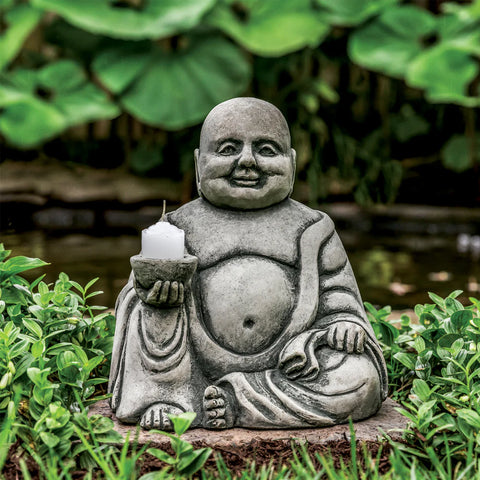4 Types of Asian Garden Statues

Asian statues are a beautiful addition to any meditation space, especially to an Asian garden. Gardens like these blend architecture and the natural world in a seamless way, allowing us to create a calming connection to our environment.
The statues within them remind us of the most valuable teachings. Whether it's a Zen statue encouraging us to pause and meditate, or a pair of guardian lions reminding us to take a breath, the right Asian statues in our garden can make all the difference.
What Are Asian Gardens?
Asian garden is a broad term encompassing traditional garden landscaping from West Asia (the Middle East), South Asia (India, Sri Lanka, and Pakistan), East Asia (Japan and China), and Southeast Asia.
Each sub-region within this vast area offers a unique landscaping design. However, when we refer to Asian gardens, we're often referring to those with a Zen Buddhist influence.
Zen Buddhism began in India but was formalized in China and later took root in Japan. Its emphasis is on meditation. So, it's no wonder that Asian gardens seem to encourage reflection and contemplation.
Unlike traditional European gardens, Asian gardens attempt to connect nature's beauty with human structures. They encourage us to connect deeply with nature by incorporating fences, bridges, and stone structures alongside natural landscapes. So, you'll find asymmetrical ponds and evergreen trees beside stone basins and symbolic statues.

Types of Asian Statues
When building an Asian garden, you'll want to include at least a few Asian statues. As with everything in this type of outdoor space, the statues have meaning. Below, we discuss some of the most common Asian garden statues in detail so you can choose ones that reflect your style and ideals.
Foo Dog Statues
Foo Dog statues are also known as Chinese Guardian lions. These stone lion figures have been guarding Buddhist temples and tomb entrances since the Han dynasty, making the oldest ones at least 1400 years old.
They almost always appear in a male and female pair. Though they look nearly identical, the male will have a ball under its left paw while the female has a cub's head in its place.
Foo dog statues can represent multiple things in an Asian garden. For some, the female represents yin energy, while the male represents yang energy, creating balance in the space.
In other pairings, the female's mouth is open, while the male's mouth is closed. This creates a physical representation of the meditational chant, "ohm." It can also mean that the female is exhaling while the male is inhaling, representing the power of the breath.

Dragon Statues
Dragon statues are common in Asian gardens and represent abundance, success, and good luck for those who deserve it. Dragons are powerful symbols in Chinese and some Japanese mythology. They also appear in Buddhist teachings.
In Buddhism, the dragon is often a metaphor for enlightenment and one's self. For example, meeting your dragon in a dark cave represents coming face to face with your darkest fears.
Having a dragon statue in your garden may encourage abundance. It can also remind you to face the obstacles in your life head-on.
Buddha Statues
Buddha statues are sometimes called Zen statues and depict the spirit of Siddhartha Gautama's spirit and teachings. They first appeared in India around 100 AD and quickly spread to Thailand and Laos. Today, you'll find them in many Asian gardens.
Buddha statues come in different forms. They can be standing, reclining, or even walking. However, most of the ones you'll find in Asian gardens are sitting.

The sitting buddha represents the teaching of meditation, making them ideal for a reflective garden. The sitting buddha's hand position, or mudra, varies from statue to statue. Each mudra has a slightly different meaning.
For example, a buddha with his hands in his lap, with his left palm up and right palm down, shows a Bhumisparsha mudra. This hand position represents calling the earth to witness. In a dhyana mudra, the buddha will have both hands facing up, with the right hand on top of the left. This hand position represents meditation.
Asian Pagoda Statues
Asian pagoda statues are a beloved symbol across East Asia that bring luck, protection and peace to any place they reside. The pagoda is usually displayed as a tiered tower with several levels of ascending height distinguished by curved or pointed roofs. It is believed that each level increases the spiritual connection between adherents and their deities. As a powerful cultural icon, its imagery appears in many Asian cultures’ art forms such as painting, ceramics and sculpture. Pagodas also have long been used as part of religious ceremonies where devotees pay homage to their deity or ancestor for support in times of need or just for providing good fortune overall. As an auspicious motif it has been gifted among family members during important occasions such as weddings, birthdays and holidays in many East Asian countries.

Final Thoughts
Placing an Asian statue in a garden is more than a decorative practice. Yes, the figure adds beauty, but it also acts as a reminder of important Zen teachings. So whether you want to encourage a meditation practice, need a reminder to take a deep breath, or simply like the energy a stone dragon brings, an Asian garden statue is worth having.


